A perfect resource for English language learners
Hello and welcome to this lesson plan with EAL games. (EAL stands for English as an additional language, so ESL or EFL would do just as well.) Here you will find a complete lesson plan to teach my preschool story Hetty and the Lion.
This story is a small sample from my resource kit for teachers needing fun EAL games, activities, and stories for children aged 3-5. This teaching resource includes:
- *10* story lesson plans with games and activities, so you know what to teach and how to do it.
- *10* beautifully illustrated stories specially written for children aged 3-5 learning English as a second language.
- Extra teaching resources such as bingo sets and flashcards.
Acknowledgement
Thanks to Valentina at Douafetecucuiete in Romania for her pictures of these EAL games and flashcards below.
These EAL games work!
“THANK YOU FOR ALL YOUR IDEAS!!!!! They are wonderful and extremely useful.
I use them in all my classes. I tell my students: “Today we are going to play one of Shelley’s games or stories,” and they already know that we are going to have fun.
It’s amazing how effective they are, and my students and I love them. Thanks again from Argentina!”
Patricia Calvinho, Argentina
The Lesson Plan
Here goes with your fun lesson plan, EAL games to prepare for the story. Depending on your children’s ability and how often they are exposed to English, you might take 1 to 3 half-hour sessions to introduce all the above words using games and other fun activities. Ideally, you would include a song or two in the lesson and perhaps a 5-minute colouring sheet or fun sheet. (All of these are included in my great resource.)
Target language for Hetty and the Lion
Greeting: Hello, how are you? I’m fine, thanks.
Nouns: lion, milk, orange, apple, banana, pear, ice cream
Verbs: drank, ate
Other: would you like some…? Oh yes, please, little
EAL Preschool Activities
Listening games for the first three fruits
Introduce the first three fruits and play Run and Touch. First, display the flashcards or the fruits and tell the children to touch the fruit you name. Then, after a few minutes, spread the flashcards out over the room and tell the children to run over to the picture you name.
How long should an EAL games lesson be?
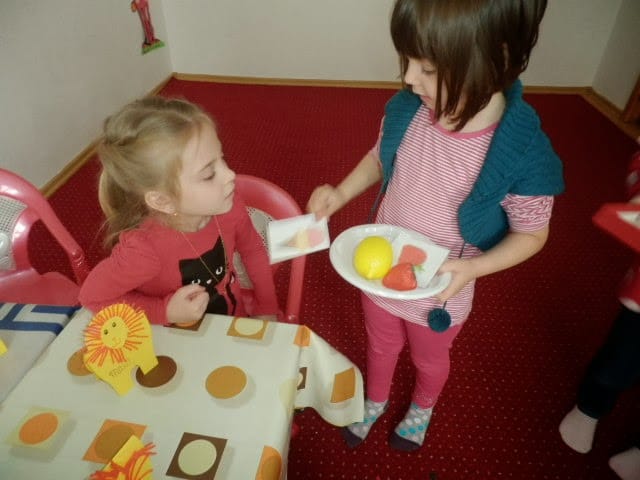
More listening games
Next, have the children make the shape of the fruit you name with their bodies.
If your children are doing well, you can introduce the other three food words and play the above games again, either with the three new words or with all six words if you have children who are fast learners. Only you can know exactly how fast to go.
Next, play Show me variation 3. In this game, you hand out a different picture card to each child who secretly looks at it and places it face down on the floor or holds it to their chest.
Musical Flashcards
Play some music (such as the Hetty and the Lion song) for ten seconds and have the children move around the room. When you stop the music, name one of the fruits, and the children with that fruit must show the picture to everyone. You can add an element where when the music stops, everyone must freeze, and only those children with the picture you have called out can move. Then, after you have called out all the vocabulary, have pupils swap cards and play again, or move on to another game.
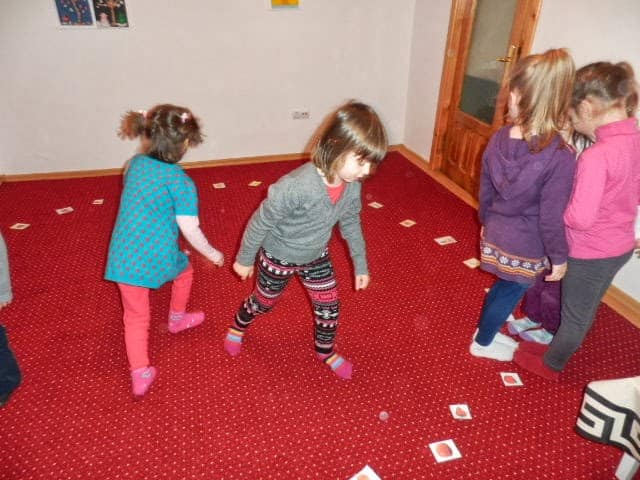
Greetings
Now you have given the children some practice understanding the first three fruits, introduce the greetings. Seat the children in a circle and take a ball. Ask the whole group, “Hello, how are you?” and have the group answer back with, “I’m fine, thanks.” Have the children repeat this back to you three or four times in unison. Now roll the ball to one child and say, “Hello, how are you?” Help the child reply to you with, “I’m fine, thanks.” The child rolls the ball back to you, and you repeat with each child. You can only do this with up to eight pupils, or it gets boring.
With a bigger group, put the children into pairs in the circle. Now you can roll the ball to two children at once, and they can reply together, which cuts down the exercise by half.
More listening games and the rest of the food words
Introduce the remaining food words and play some more listening games. For a listening game that revises colours, name the fruit, and the children call out its colour. For example, you say, “banana,” and the children say, “yellow.”
Musical fruits
Display the colours of the fruits and the milk on the floor. With a large group, you will want several of each colour. If you have my story set, use the coloured feet from story 3. A Twister sheet is a great idea and is easy to make. There’s one in the picture below. First, play music while the children dance around. Then call out a question such as, “what colour is a banana?” Next, the children must jump on the colour yellow. This listening game allows them to hear new words several times in preparation for saying them, and it also provides revision of colours. Remember to include, “what colour is milk?” as well as the fruits.
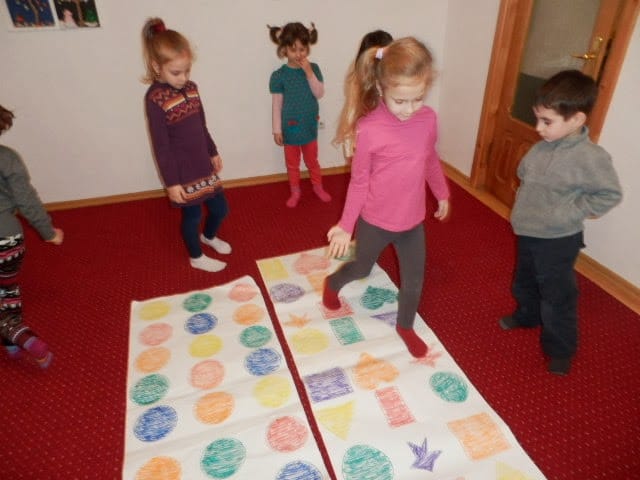
If your children do not know the colours then play musical fruits by just naming the fruits and food vocabulary and letting pupils jump on the correct pictures. You will need duplicate flashcards, so the whole group does not converge on one small picture. Please ensure pupils have enough images and space to move around without bumping into each other.
Speaking games
You may decide to leave these speaking games until after you have read the story or for another lesson – it just depends on your group. If you feel your children are not ready for these games, skip ahead to more listening games where you introduce the question, Would you like some..?
Mystery box
When the children are ready for some speaking practice, play games such as Mystery box, where you cut holes in a cardboard box, turn the box upside down, and place fruits inside. Then, students feel inside the box and try to name an item.
Cut several holes in the same box so several children can participate at the same time. If you have a big group, you will need more than one box. I suggest two to four children per box, so if you have eight children, one box is enough, as the others can wait a turn. However, if you have 12 children, I recommend two boxes, as you do not want half of the children sitting around doing nothing for more than a minute or two. Too much sitting around, and you may start to have discipline problems.
You can play a variant of this where you place three objects in the box. Two are matching, and one is the odd one out. For example, place two oranges and one banana in the box. The children feel inside and name the odd one out.
Hide and Guess game
Play a guessing game such as Hide and Guess, where a child picks up a fruit and hides it in a bag. The others guess what is in the bag or guess which fruit is missing from the ones visible. See the picture below for this game in action.
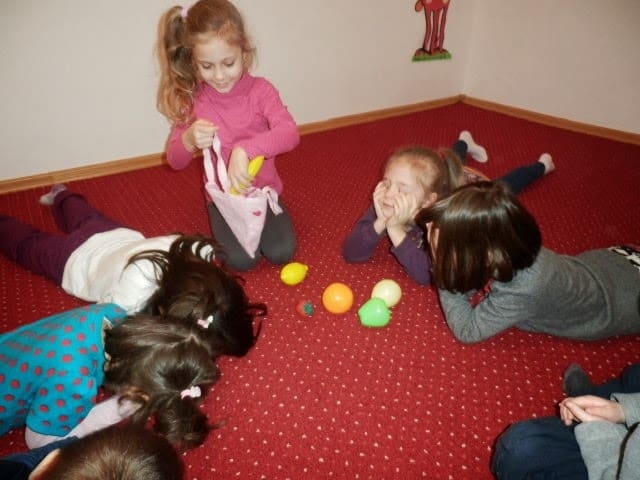
Listening games to introduce would you like some?
Moving on now from simple vocabulary words to the key phrase in the story, Would you like some..? At this stage, a few listening games should suffice so that pupils can understand the meaning of this phrase and follow the events in the story. First, explain the question and then ask each child if they would like some ice cream, apples, etc. Let the children answer yes or no, and if they answer yes, hand them the fruit or a picture of the fruit, and the children can pretend to eat it.
Play All Change
In this game, hand out the fruit and food words that the children have learned so far. Next, hand out pairs of words so that two children have the same item. You then ask the question, would you like some apples? The two children with an apple or a picture of an apple change places. Continue through all the vocabulary.
Then you jazz the game up by putting one child in the middle. This time, when the two children change places, the child in the middle must try to jump into one of the spots in the circle, leaving someone else to go in the middle. There are six food words in this story, which would mean that you could play with thirteen children – one being in the middle.
Suppose you have more than thirteen children and have a helper; consider forming two groups and let the helper look after the second group. If that is not possible, you will have to have up to three children holding the same cards. This game can be chaotic with more than 15 children, so make two groups and find an assistant!
If you have less than thirteen children, then instead of handing out two bananas, two apples, etc., hand out all the vocabulary and ask, would you like some apples and bananas? Then the child with the apples changes places with the child with the bananas.
Calm the kids down if you need to
During the lesson, when you want to calm the children down or give them a break, you can hand out the black and white version of the vocabulary and allow the children to colour them.
Flashcards for the lesson plan
The word lion is not included in the above eal games to keep everything to a food theme. However, you will be able to introduce the lion just before you tell the story.
Here now is the link to your flashcards that you can use to pre-teach all the target language. In addition, you will find a colour set to use in the games and a black and white set for colouring.
Natural fruits are ideal for young children because they are more authentic, but flashcards work too if you cannot access real objects; and for some of the games, flashcards are more practical.
After the lesson
You should now be ready to read the story to the children, who, with the aid of the coloured illustrations, will follow and understand the events.
You will be able to follow up with more eal games and activities to revise, reinforce and spend more time practising speaking. The following blog in this series contains the story with illustrations and activities to do during the story.
I hope you like this approach and have fun with the games and ideas above as you prepare your children for Hetty and the Lion.
Lots more preschool EAL games
You will like my book of over one hundred preschool games to teach any vocabulary and language if you like these ideas. There are so many variations that you will have enough ideas to keep your preschoolers happy for several years!
Read reviews here or take advantage of the excellent value I am extending to you via the featured product below.
All the best, Shelley Ann Vernon, Teaching English Games
- Games
Preschool games book
Rated 0 out of 5€19.97Original price was: €19.97.€11.97Current price is: €11.97. Add to cart
- Preschool
ESL Preschool Stories 1-10 Teaching Kit + PowerPoints
Rated 0 out of 5€39.97Original price was: €39.97.€29.33Current price is: €29.33. Add to cart
The following blog
Once you have taught the above lesson plan, perhaps over several sessions, you are ready for the story. You may download Hetty and the Lion story here.
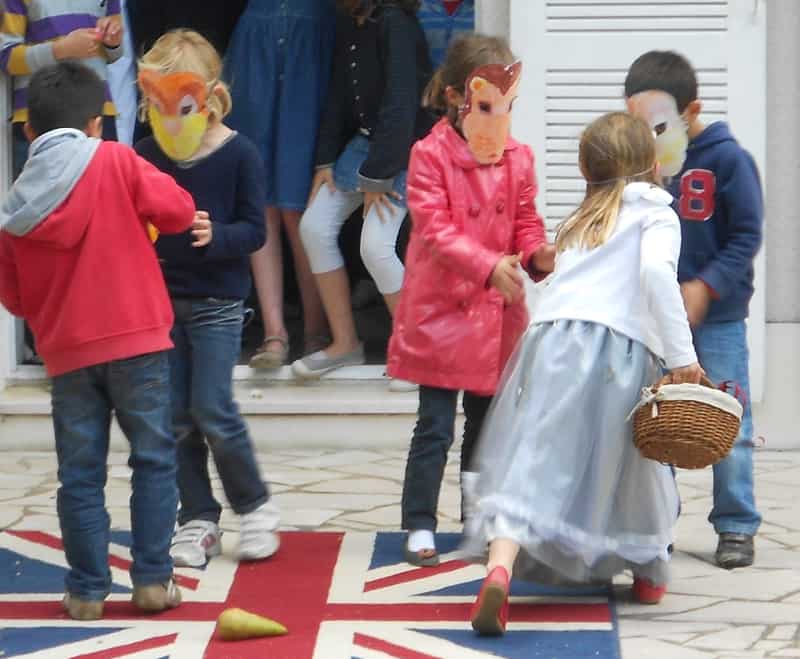
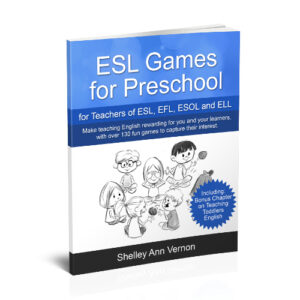
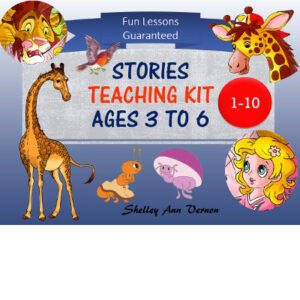
2 thoughts on “EAL games for preschool learners”
Hello Shelley Ann Vernon, Thank-you for this sample lesson. I was wondering : do you recommend reading the story at end of the lesson or in the next lesson ?
Thank-you very much for all these ideas and tips !
Dear Morin,
It doesn’t really matter – read the story when you have introduced and practised the new vocabulary and main phrases. Then, in future lessons you could have pupils work on the story in small groups and present it as a role-play.
All the best
Shelley